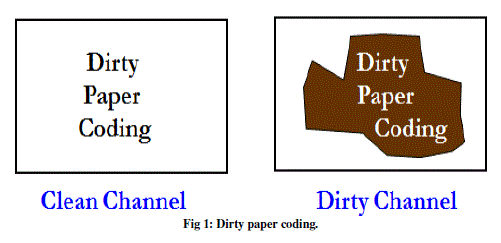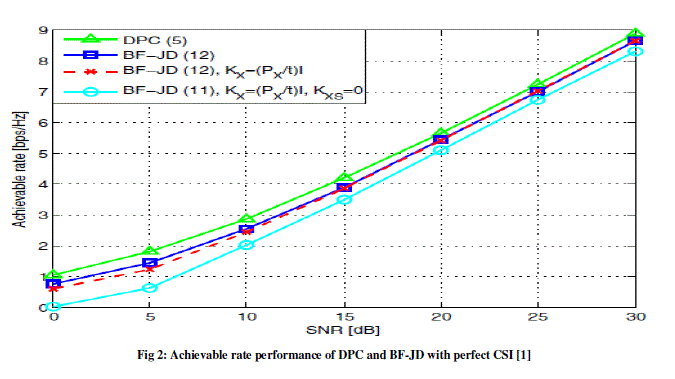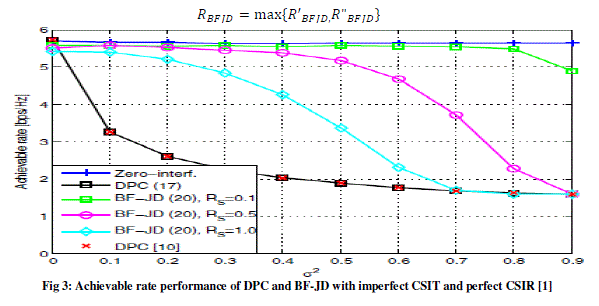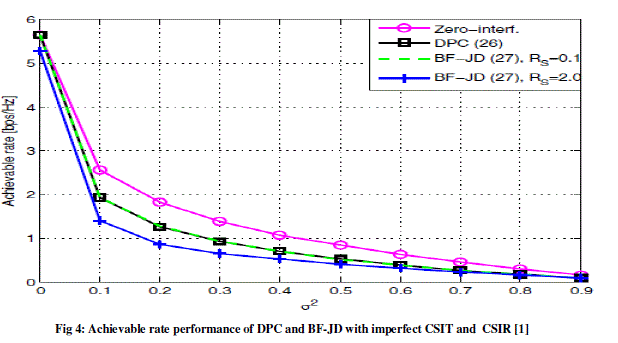Keywords
|
| CSI, DPC, Beamforming, MIMO system,etc |
INTRODUCTION
|
| Interference is becoming a major problem in wireless communication systems. So, there are various technologies that are emerging for reducing the interference in such a system. However, some systems are able to cancel the interference completely while some systems can only attempt to reduce the interference. For reduction of interference the channel state information is to be estimated. The CSI refers to known channel properties of a communication link. This information describes how a signal propagates from the transmitter to the receiver and represents the combined effect of, for example, scattering, fading, and power decay with distance. The CSI makes it possible to adapt transmissions to current channel conditions, which is crucial for achieving reliable communication with high data rates in multiantenna systems. |
| CSI needs to be estimated at the receiver and usually quantized and fed back to the transmitter (although reverse-link estimation is possible in TDD systems). Therefore, the transmitter and receiver can have different CSI. The CSI at the transmitter and the CSI at the receiver are sometimes referred to as CSIT and CSIR, respectively. |
| Beamforming or spatial filtering is a signal processing technique used in sensor arrays for directional signal transmission or reception. This is achieved by combining elements in a phased array in such a way that signals at particular angles experience constructive interference while others experience destructive interference. Beamforming can be used at both the transmitting and receiving ends in order to achieve spatial selectivity. The improvement compared with omnidirectional reception/transmission is known as the receive/transmit gain (or loss).Beamforming can be used for radio or sound waves. It has found numerous applications in radar, sonar, seismology, wireless communications, radio astronomy, acoustics, and biomedicine. Adaptive beamforming is used to detect and estimate the signal-of-interest at the output of a sensor array by means of optimal (e.g., least-squares) spatial filtering and interference rejection. |
| In probability theory and statistics, a sequence or other collection of random variables is independent and identically distributed (i.i.d.) if each random variable has the same probability distribution as the others and all are mutually independent. The abbreviation i.i.d. is particularly common in statistics (often as iid, sometimes written IID), where observations in a sample are often assumed to be effectively i.i.d. for the purposes of statistical inference. The assumption (or requirement) that observations be i.i.d. tends to simplify the underlying mathematics of many statistical methods (see mathematical statistics and statistical theory). |
| However, in practical applications ofstatistical modeling the assumption may or may not be realistic. The generalization of exchangeable random variables is often sufficient and more easily met.The assumption is important in the classical form of the central limit theorem, which states that the probability distribution of the sum (or average) of i.i.d. variables with finite variance approaches a normal distribution. |
| In radio, multiple-input and multiple-output, or MIMO (commonly pronounced my-moh or me-moh), is the use of multiple antennas at both the transmitter and receiver to improve communication performance. It is one of several forms of smart antenna technology. Note that the terms input and output refer to the radio channel carrying the signal, not to the devices having antennas.MIMO technology has attracted attention in wireless communications, because it offers significant increases in data throughput and link range without additional bandwidth or increased transmit power. It achieves this goal by spreading the same total transmit power over the antennas to achieve an array gain that improves the spectral efficiency (more bits per second per hertz of bandwidth) or to achieve a diversity gain that improves the link reliability (reduced fading). In MIMO systems, a transmitter sends multiple streams by multiple transmit antennas. The transmit streams go through a matrix channel which consists of all Nt Nr paths between the Nt transmit antennas at the transmitter and Nr receive antennas at the receiver. Then, the receiver gets the received signal vectors by the multiple receive antennas and decodes the received signal vectors into the original information. |
DECODING METHODS
|
| There are two methods of decoding the data at transmitter as well as receiver for reducing the interference. We are going to elaborate this methods as follows: |
| A. DPC |
| In telecommunications, dirty paper coding (DPC) is a technique for efficient transmission of digital data through a channel subjected to some interference known to the transmitter. The technique consists of precoding the data in order to cancel the effect caused by the interference. Dirty-paper Coding achieves the channel capacity, without power penalty and without requiring the receiver to gain knowledge of the interference state.In this technique, the signal which is to be transmitted is only encoded at transmitter and the decoder at the receiver must know how to read or decode this codeword. It can be explained by one example, suppose a plain paper is taken and something is written on the paper so we know the writing matter is our message signal . If we colour the written portion on the paper by ink then we know that only the coloured portion gives the message signal. By this example it is cleared that in DPC the message signal is only encoded and sent through the channel. At receiver side the message signal is decoded. This technique is useful when the CSI is perfect at both the transmitter and receiver..Fig.1 shows how the data is coded in dirty paper coding. |
 |
| B. BF-JD |
| Unlike, the DPC technique BJ-JD (Beamforming with joint decoding). Both the message signal and the interference signal are encoded at the transmitter together and sent by channel. At receiver side both are jointly decoded. At the decoding side the decoder consider the interference signal as a codeword of interferer’s codebook. Thus, both codewords are separated. This technique is useful when the channel state information is imperfect at transmitter and perfect at the receiver.As, we know in beamforming the signal which is to be transmitted is sent through a array of transducers such as radio antenna and the directionality of the signal is set . The beamforming is a general signal processing technique which is also called as “spatial filtering”. It reduces the signal energy loss and it also controls phase and amplitude. It is also used to reduce the multipath fading. |
TYPES OF CSI
|
| In this section , we are going to discuss the various types of channel state information. The channel state information is estimated at transmitter or receiver side with the help of some prediction models. The data from the measured channel information transmitter decides or adapt the transmission parameters, modulation techniques to transmit the data and the CSI is feedback from transmitter or receiver. So that the either transmitter or receiver knows about the selected transmission parameters. When the estimated channel state information is correct then it is called as perfect CSI and when the channel state information is estimated incorrectly it is known as imperfect CSI. Depending on the estimated values the CSI can be categorized in to two types: |
| A. Perfect CSI |
| In this type we consider that the channel state information is perfect both at the transmitter as well as the receiver When the channel state information is perfect then DPC outperforms BF-JD technique. Because, in this case the DPC is able to obtain the same rate as for a channel without interference.so, the channel capacity remains same as there is no interference. And in this case the DPC is able to cancel the interference due to the knowledge of interference at transmitter side only and there is no need to have knowledge of interference at the receiver side.When the CSI is perfect both at the transmitter as well as receiver then the technique known as DPC is used. It is clear from fig.2 that when CSI is perfect the performance of DPC technique is better than BF-JD. And the BF-JD technique is not able to improve the performance which DPC can.The achievable rate performance is given by [1], |
 |
 |
| B. Imperfect CSI |
| When the CSI is imperfect there are two cases which have to be considered they are the CSI is imperfect at the transmitter and perfect at the receiver and the another case where the CSI is imperfect both at the transmitter as well as the receiver. When the CSI is imperfect at the transmitter and perfect at the receiver the beamforming with joint decoding outperforms DPC. And in the case when CSI is imperfect both at the transmitter as well as receiver then both the DPC and BF-JD techniques try to cancel the interference. But the DPC outperforms BF-JD because the rate Rs is to be required to be small in BF-JD so it can cancel the interference and if the rate Rs is somewhat greater then DPC outperforms BJ-JD. So, DPC gives better performance as compared to BF-JD when the CSI is imperfect both at the transmitter as well as receiver. When the CSI is imperfect at the transmitter and perfect at the receiver the BF-JD outperforms DPC.From the figure.3 it is clear that the the achievable rate performance of BF-JD is better than DPC.It is given by equation in [1], |
 |
| Now, let us see the case when the CSI is imperfect both at the transmitter as well as receiver . As discussed previously the DPC outperforms BF-JD in this case.As it is required in BF-JD that its rare Rs should be as small as possible so as to cancel the interference bot this may not be possible always so, DPC gives better performance when the CSI is imperfect both at the transmitter as well as the receiver.Now as we have seen all the cases of the channel state information (CSI) we can say that DPC gives better performance when the CSI is perfect both at the transmitter as well as the receiver.When the channel state information is imperfect at the transmitter and perfect at the receiver then the beamforming with joint decoding technique outperforms DPC.And in the case when the channel state information is imperfect both at the transmitter as well as the receiver then the technique known as DPC outperforms BJ-JD due to its rate factor Rs which is required to be small. There is one more case, which is not considered i.e. when the channel state information is perfect at the transmitter and inperfect at the receiver.But usually this case is not possible practically that the transmitter is perfect because the interference is added with the information when it is transmitted. |
| In the case when channel state information is imperfect both at the transmitter as well as receiver both the techniques i.e. DPC and BF-JD can only attempt to cancel the interference but they cannot sure about completely reducing the interference.From the figure.4 it is clear that both the techniques are nearby about zero interference.The BF-JD technique should have the rate is small enough so that the interference is decodable. |
 |
CONCLUSION
|
| As per the discussion it is clear that reducing the interference is an important and critical task in wireless communication systems.In this paper, we have stated the two techniques which are used to mitigate the interference i.e. DPC and BJ-JD. In MIMO systems, the effect of imperfect channel state information with interference is discussed an from the discussion it is clear that the MIMO system is affected by the interference. So that the interference avoidance or reduction techniques shall be introduced. The channel state information should be estimated properly and depending upon this estimation the appropriate method should be applied. In perfect CSI case the DPC technique proves the better performance while the imperfect CSI case there are two cases. Whether the CSI is imperfect at transmitter or receiver. The BF-JD technique is useful when the CSI is imperfect at the transmitter and perfect at the receiver which consider interference as interferer’s codeword. In the case of CSI is imperfect at both transmitter as well as receiver the decoding technique depends on the achievable rate. If the rate is small then only BF-JD can be used otherewise the DPC is good in comparison. |
| |
References
|
- Namjeong Lee, Osvaldo Simeone and Joonhyuk Kang,“ The Effect of Imperfect Channel Knowledge on aMIMO System with Interference”, IEEE Trans. Commun., vol. 60, no. 8, pp no.2221-2229 August 2012.
- G. Caire, A. Adhikary, and V. Ntranos, “Cognitive femtocells: breaking the spatial reuse barrier of cellular systems,” 2011 ITA Workshop
- S.-C. Lin, P.-H.Lin, C.-P.Lee, and H.-J. Su, “Filter and nested-latticecode design for fading MIMO channels with side-information,” IEEETrans. Commun., vol. 59, no. 6, pp. 1489–1494, June 2011
- F. Baccelli, A. E. Gamal, and D. Tse, “Interference networks with pointtopoint codes,” Feb. 2011. Available: http://arxiv.org/abs/1102.2868
- A. E. Gamal and Y.-H. Kim, “Lecture note on network informationtheory,” June 2010. Available: http://arxiv.org/abs/1001.3404
- O. Simeone, E. Erkip, and S. S. (Shitz), “On exploiting the interferencestructure for reliable communications,” in Proc. 2010 Conf. Inf. Sci.Syst.
- C. S. Vaze and M. K. Varanasi, “Dirty paper coding for the MIMOcognitive radio channel with imperfect CSIT,” in Proc. 2009 IEEE Int.Symp. Inf. Theory, pp. 2532–2536.
- A. D. Dabbagh and D. J. Love, “Multiple antenna MMSE baseddownlinkprecoding with quantized feedback or channel mismatch,”IEEE Trans. Commun., vol. 56, no. 11, pp. 1859–1868, Nov. 2008. I. Mari´c, N. Liu, and A. Goldsmith, “Encoding against an interferer’scodebook,” in Proc. 2008 Allerton Conf. Commun. Control Comput., pp.523– 530.
- C. S. Vaze and M. K. Varanasi, “Dirty paper coding for fading channelswith partial transmitter side information,” in Proc. 2008 AsilomarConf.Signal, Syst. Comput., pp. 341–345.
- A. Bennatan and D. Burshtein, “On the fading-paper achievable regionof the fading MIMO broadcast channel,” IEEE Trans. Inf. Theory,vol. 54, no. 1, pp. 100–115, Jan. 2008.
- W. Zhang, S. Kotagiri, and J. N. Laneman, “Writing on dirty paper withresizing and its application to quasi-static fading broadcast channels,”in Proc. 2007 IEEE Int. Symp. Inf. Theory, pp. 381–385.
- M. Sharif and B. Hassibi, “A comparison of time-sharing, DPC, andbeamforming for MIMO broadcast channels with many users,” IEEETrans.Commun., vol. 55, no. 1, pp. 11–15, Jan. 2007
- P. Mitran, N. Devroye, and V. Tarokh, “On compound channels withside information at the transmitter,” IEEE Trans. Inf. Theory, vol. 52,no. 4, pp. 1745–1755, Apr. 2006.
- T. Yoo and A. Goldsmith, “Capacity and power allocation for fadingMIMO channels with channel estimation error,” IEEE Trans. Inf. Theory,vol. 52, no. 5, pp. 2203–2214, May 2006
- S. Yang and J. Belfiore, “The impact of channel estimation error on theDPC region of the two-user Gaussian broadcast channel,” in Proc. 2005Allerton Conf. Commun. Control Comput., pp. 1366–1372.
- B. Wang, J. Zhang, and A. Høst-Madsen, “On the capacity of MIMOrelay channels,” IEEE Trans. Inf. Theory, vol. 51, no. 1, pp. 29–43, Jan.2005.
- M. Médard, “The effect upon channel capacity in wireless communicationsof perfect and imperfect knowledge of the channel,” IEEE Trans.Inf. Theory, vol. 46, no. 3, pp. 933–946, May 2000.
|